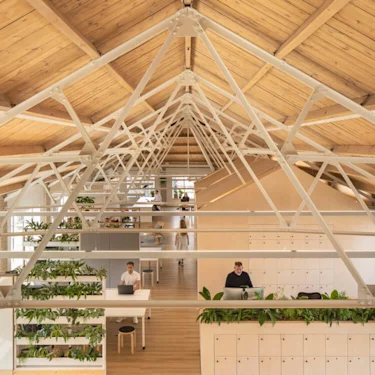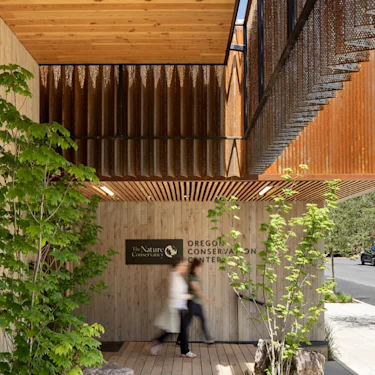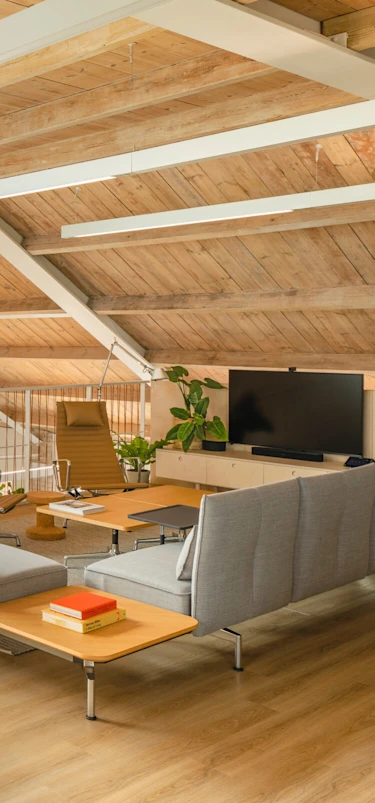Workplace
March 2, 2023
The Adaptable Office
The new climate of the American workplace is moving away from frat-house-style gimmicks toward a more thoughtful future.
Words by Ian Volner
Photos courtesy Interior Architects & Lever Architecture
At the height of the Covid crisis, the public was treated to an onslaught of takes regarding the possible long-term effects the pandemic might have on when, how and (most of all) where Americans would return to work. “Has the Pandemic Transformed the Office Forever?” asked The New Yorker. “Employees’ Needs Are Changing Work Spaces,” declared The New York Times. The demise of office-based work, or at least dramatic changes in the way workspaces are designed, seemed inevitable.
Three years later, where are we? From the looks of things, in a pretty interesting place — though not necessarily where many imagined. No question, the disruptions of the shutdown have had a lasting effect on the white-collar workforce. Even with U.S. unemployment touching lows not seen since the late 1960s, companies nationwide are seeing less and less value in maintaining dedicated facilities of their own, with annual office sales down $30 billion in 2022 and office vacancies nationwide rising to 16.6% according to new data from CommercialEdge. But while the culture of work has unquestionably changed, the implications for workplace design are subtler, and in many ways more interesting, than those envisioned three years ago.
“Before the pandemic, it was all about density, efficiency, how many people can you get into the space,” says Reetika Vijay. As managing principal at the Boston office of international design firm Interior Architects (IA), Vijay has worked on office projects around the country and around the world, creating spaces for a demanding corporate clientele. But what they demand has shifted. “The majority are saying: ‘We’re not the same as we used to be,’” she says, leaving Vijay and her partners scrambling to catch up.
The IA team has managed to switch gears with surprising speed. For a security company called SimpliSafe, designers are updating a pre-pandemic scheme for the post-pandemic workforce by focusing on what Vijay calls “human-centric values.” In her practice, that means making spaces that put employees in charge.
The firm has made its recently completed London outpost an exemplar of its approach: offering more ways to work via collaborative workstations, breakout spaces, conference rooms that can be sealed off and recombined at will and better amenities — including a dedicated meditation room that can double as a nursing station. The design puts an accent on flexibility, making the transition from work-from-home to the office as seamless as possible — right down to the homey, gable-roofed look of the new interior.

But as much as these changes represent a step forward for office design, they don’t exactly signal a giant leap; on the contrary, they suggest that many of the best trends in office design from before the pandemic have simply continued on and been accelerated by the Covid experience. Thomas Robinson is the founding principal of Portland, Oregon–based Lever Architecture, and as he points out, none of the individual items on the new-office agenda is truly novel. “The fundamentals are more or less the same pre- or post-Covid,” he says. “Great space plus good design equals a healthy environment.”
With a special expertise in innovative all-timber construction, and an organic approach to form-making, Robinson’s practice was known long before 2020 for designing projects with pandemic-friendly features — especially extensive use of outdoor spaces. It’s a particular highlight of the Nature Conservancy, an eco-nonprofit also in Portland that makes extensive use of Lever’s signature structural wood while providing plenty of places for workers to get a little fresh air. “I call them ‘mid-door’ spaces,” says Robinson. In the Nature Conservancy building, many of the primary meeting rooms and public areas have a terrace extension that can be combined with enclosed spaces to create open, crowd-friendly environments. It’s a net positive for employee wellness with an extra dose of visual appeal.

Still, the question of what, exactly, appeals to today’s workforce — what gets people into the office in the first place and keeps them coming back — is itself something of a puzzle. “Our biggest issue,” says architect Lissa So, “is trying to figure out how do we activate the place, make it a place where people really feel like they’re coming together.” For Manhattan-based Marvel Architects, of which So is a founding partner, the problem recently struck close to home: In creating a new mixed-use annex for their own downtown office, the team was tasked with creating a space for events, meetings and collaborations that could exemplify the future of work, as they saw it. How could they bring staff together in innovative ways that could also attract like-minded job seekers to join them?
Their solution puts much the same emphasis on adaptability and organicism seen in their colleagues’ work, with workspaces that can change form and function via movable screens and a rear-facing space that opens up to a modest courtyard.
But the design also manifests something more abstract, a sort of attitude that may be at the heart of the post-pandemic office trend. As So puts it, “The trick is finding a balance.” That means balance between spaces where people can collaborate and quiet spaces where they can be alone; balance between giving people reasons to show up and making sure they don’t feel tied down or surveilled.
“People want to have a sense of ownership of their workspace,” says So, “even though they might only want to come in two days a week.” In the Marvel annex, the casual ambience, natural finishes and subdued lighting speak as loud as anything else about the new climate of the American workplace: a place where the focus is less on foosball tables, beer taps and work-as-lifestyle gimmicks and more on supporting a healthier and more empowered workforce.
